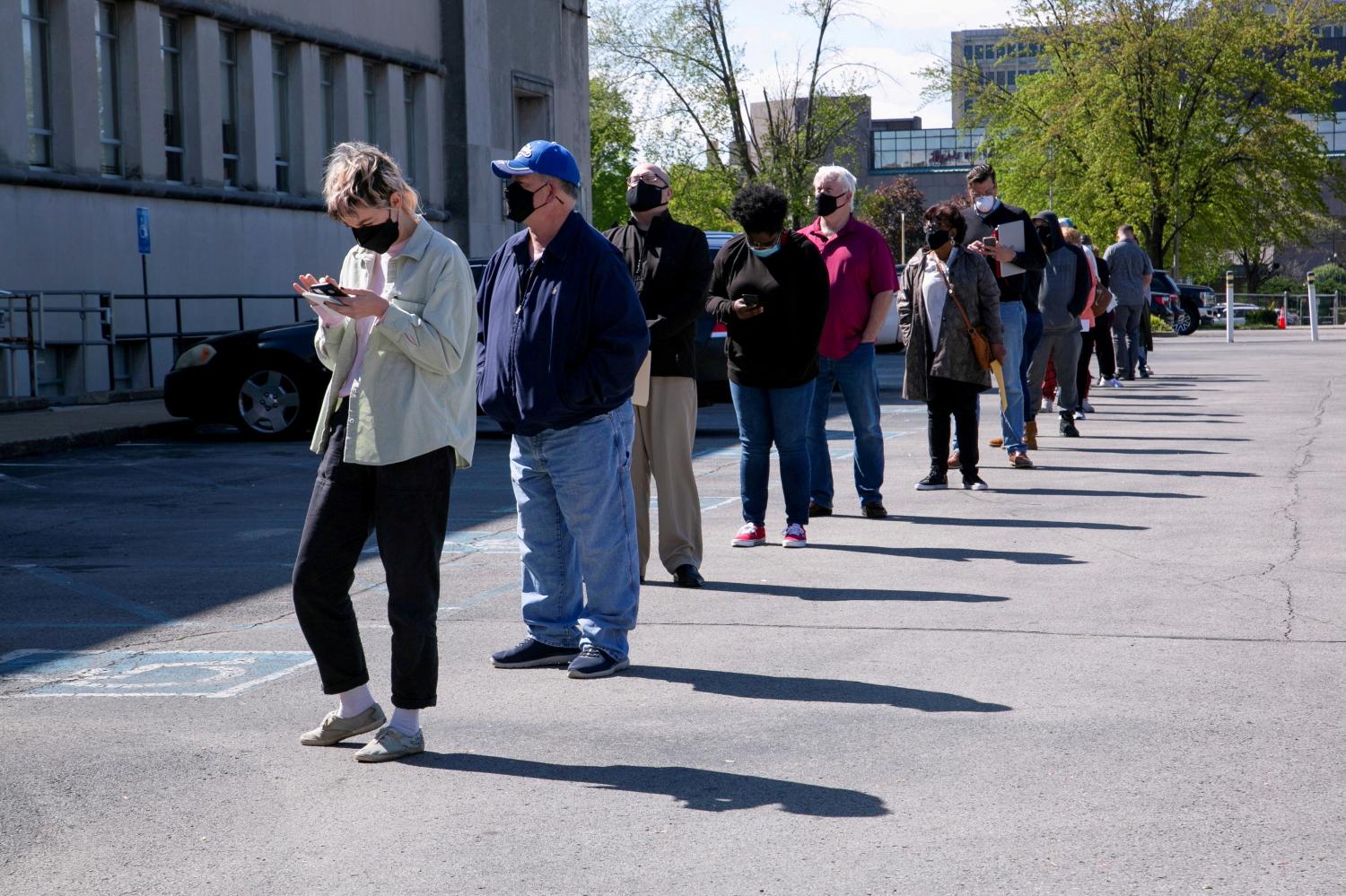Contents
- Job losses have disproportionately hit the low-wage workforce
- The displaced low- and mid/high-wage workforce face different barriers to work reentry
- Myriad issues hold the displaced workforce back from reemployment
- Returning to the status quo should not be the goal—and may not even be an option
- We need to create more jobs, but also better jobs
The recession associated with the COVID-19 pandemic announced itself in spring 2020 with head-spinning job losses: 22 million lost jobs within two months, a shock that is hard to overstate.
But aside from a brief winter setback due to surging COVID-19 cases, the U.S. economy has, fortunately, gained jobs each month since this initial hemorrhage. Earlier this month, the Bureau of Labor Statistics (BLS) announced the economy added an expectations-beating 850,000 jobs in June, and wages also rose. This is unreservedly good news, but the economy is still down 7 million jobs, long-term unemployment is up, and many workers and families continue to struggle.
Pandemic-induced job losses hit low-wage workers much harder than those earning higher wages and, although hiring accelerated in low-wage industries last month, low-wage jobs have been the slowest to return. This is not to downplay the toll that losing a job can take on workers at all levels, and indeed, there are middle- and higher-income workers among the recession’s victims as well. It is an unsettled time in the labor market.
In this analysis, we build upon work by the Urban Institute that estimates COVID-related job loss by industry and geography. Using monthly data from the BLS Current Employment Statistics program, the Urban Institute calculates industry job loss at the local level and links that data to the Census Bureau’s American Community Survey (ACS) to estimate the number of jobs that have not yet recovered compared to February 2020 by county and metro area. We build upon their work by looking not at the number of jobs lost, but the characteristics of the workers who held those jobs—whom we refer to as “displaced”—using 2014-2018 ACS 5-year IPUMS USA microdata.
|
What do we mean by ‘displaced’? The term “displaced” refers to people who have lost their jobs during the pandemic, and whose jobs have not yet recovered. We use “displaced” instead of the more familiar term “unemployed” because the official definition of unemployment means that someone is actively looking for work. While that is the case for some, displaced individuals may also have left the labor force entirely or found a new job. |
While we can’t be certain about the current employment situations facing this displaced population, the people that held these yet-to-be-recovered jobs are more exposed to the risk of ongoing unemployment and labor market changes the pandemic has accelerated. Moreover, given that so many of these displaced workers were economically vulnerable before the pandemic, they are also less able to weather this risk than other workers. We hope the data that follows can support national and regional leaders in crafting more responsive policies and programs to reactivate their economies. (To learn more about the methodology, please refer to the data appendix.)
Job losses have disproportionately hit the low-wage workforce
|
Defining ‘low wages’ “Low wages” are defined as two-thirds of the median hourly wage for full-time, full-year male workers: $16.67 per hour in 2018. We then adjust this threshold to account for variation in local cost of living. The low-wage threshold varies from $13.10 in Beckley, W.Va. to $21.60 in San Francisco. See the data appendix for all place-specific thresholds. For more analysis using this definition, please see our 2019 report, Meet the low-wage workforce. |
Prior to the onset of the pandemic, low-wage earners comprised 43% of the workforce. More than a year into the pandemic, they comprise 52% of the displaced—nearly 10 percentage points higher than we would expect if low-wage and mid/high-wage jobs were recovering at an equal pace.

Similarly, the impact of the pandemic recession differed regionally, with the nation’s metropolitan areas experiencing an uneven recovery. Even so, low-wage workers are overrepresented among the displaced populations of metropolitan areas in nearly every case, reaching an overrepresentation high of 19 percentage points in San Jose, Calif.

The displaced low- and mid/high-wage workforce face different barriers to work reentry
Losing a job can be devastating for anyone, regardless of income level. But it can be especially turbulent for those already living paycheck to paycheck or without alternative sources of income.
Much of the displaced low-wage workforce was in an economically precarious position before the pandemic. They earned average hourly wages of only $10.40 per hour, less than a third of the average hourly wage of the displaced mid/high-wage workforce ($33.80 per hour), and equal to only $22,000 annually if working full time. Some displaced low-wage workers may have been able to fall back on the income of other family members, but even before pandemic-induced job losses, about two in five were living below 200% of the poverty line, suggesting lean finances to begin with. By contrast, only 7% of mid/high-wage workers lived below the 200% of the poverty line. (200% of the federal poverty level is equivalent to about $40,000 per year for a family of three in 2018 dollars.) More than one in four low-wage workers were receiving safety net benefits such as food assistance or Medicaid.
The demographic characteristics of the displaced low- and mid/high-wage workforce also reflect the fault lines in our economy. The displaced low-wage workforce is far younger, more racially and ethnically diverse, and have completed less formal education than the displaced mid/high-wage workforce.

Nearly one-third of the displaced low-wage workforce are young adults aged 16 to 24. Recessions are especially hard on young people, and long periods of youth unemployment—as long 16 months in this case—can leave a decades-long wage scar. Aside from these young adults, more than half of this group are in their prime working years: ages 25 to 54. The displaced low-wage workforce’s low levels of education are also concerning given education’s importance to accessing good jobs. Together, these factors indicate displaced low-wage workers may struggle to land on their feet.
Meanwhile, the mid/high-wage displaced workforce may have a somewhat easier time reentering work and maintaining economic security. The group’s relatively low poverty rates indicate they were more likely to have other savings or income to rely on, and they will be more competitive for jobs given their higher education levels. Displaced mid/high-wage workers are also less likely to be members of demographic groups who face discrimination in the labor market—namely, women and people of color. However, more than one-third of the displaced mid/high-wage workforce have children—considerably higher than the displaced low-wage workforce—and disruptions in school, summer camp, and day care availability likely hinder their return to work.
Myriad issues hold the displaced workforce back from reemployment
Prior to the pandemic, 40% of the displaced low-wage workforce was employed in leisure and hospitality. This sector has the furthest to go in the recovery—it’s still down more than 2.2 million jobs. Mid/high-wage workers were less hyper-concentrated in a single industrial sector, but many also worked in leisure and hospitality, as well as education and health services and manufacturing.

Turning to occupations, the displaced low-wage workforce was concentrated in occupations requiring face-to-face interactions with the public, such as retail clerks and food service workers. These occupations offer low average wages and fewer fringe benefits than higher-wage occupations. Indeed, four of the five most common occupations among this group pay less than $15 per hour.

In the near term, the reemployment of the displaced workforce is tied to the recovery of these jobs to pre-pandemic numbers, as much as it’s possible. Given the sheer number of jobs still missing in the leisure and hospitality sector, the low-wage displaced in particular may also need to change industries to become reemployed in the immediate term. But that’s easier said than done—changing industries can often require additional education, job-specific training, or connections.
Lack of employer demand is not the only issue at hand, however. Other factors are stymying the recovery, as evidenced by the fact that some employers report having trouble filling open positions. Some workers may still be restricted by limited child care availability while schools are closed for the summer and child care centers themselves struggle to hire workers.
And of course, we also cannot discount continuing fear of COVID-19 infection. Many low-wage jobs, such as those in leisure and hospitality, involve extensive face-to-face interaction with the public, which inherently puts workers at greater risk of contracting COVID-19. Some point to temporarily enhanced unemployment benefits as keeping workers from returning to work, but it will take time to both gather and disentangle the conflicting evidence before we can be sure.
Lastly, and more fundamentally, people may be rethinking the jobs they are willing to do and for what pay. Some of these factors will likely resolve themselves as normal economic activity resumes, but some may not.
Returning to the status quo should not be the goal—and may not even be an option
Last spring’s COVID-related job losses were shocking and highly visible, but the February 2020 labor market was already in a crisis condition. Low-wage work had become normalized, and policymakers were so focused on a low unemployment rate that the country had become desensitized to a labor market in which millions of people struggled to earn enough to support themselves and their families. There simply were not—and are not—enough jobs paying decent wages for people without college degrees (who make up the majority of the workforce) to escape low-wage work.
Recently, there have been promising signs that wages are increasing, and even more so among some low-wage occupations. But inflation is also rising, reducing the buying power rising wages offer. Moreover, wage trends are not the only data point to consider—wage levels matter, too. An uptick in wages does not compensate for decades of stagnation.
It is also likely that some jobs will never return, particularly in lower-wage occupations and sectors. The pandemic has resulted in what may be permanent changes in the economy. Recessions accelerate automation and some low-wage roles, such as cashiers and retail salespersons, are especially susceptible. Mid-wage occupations, too, are not immune. At least some permanent shift to telework may also reduce the need for office space, transportation, and downtown retail cores.
Taking these trends into account, the BLS reduced its 2029 employment projections for a majority of industries—most dramatically for leisure, hospitality, and retail trade, all of which employ multitudes of low-wage workers. McKinsey & Company predicts that as a result of the pandemic, “more than half of displaced low-wage workers may need to shift to occupations in higher wage brackets and requiring different skills to remain employed.” David Autor and Elisabeth Reynolds emphasize that pandemic-induced labor market changes will reduce demand for low-wage workers without commensurate increases for these workers in higher-wage jobs, potentially lowering wages even more.
We need to create more jobs, but also better jobs
Without job growth, we can’t reduce unemployment and coax people back into the labor force. But we also need to think about the kinds of jobs we generate, whether they pay enough to live on, and to whom they are available. (We’re looking at you, employers who require bachelor’s degrees that may or may not be necessary, and that rely on exclusive social and professional networks to recruit new hires.)
Absent changes in public policy and employer hiring and business practices, the future for displaced low-wage workers looks grim. Prior to the pandemic, low-wage work was often a dead end rather than a stepping stone. In fact, economists at the Federal Reserve Bank of New York found low-wage workers were more likely to become unemployed than transition to a better-paying occupation over a 12-month period. Research by Brookings colleagues Marcela Escobari, Ian Seyal, and Carlos Daboin Contreras identified workers in the hospitality sector as especially unlikely to transition to higher-paying jobs.
Several years ago, Maureen Conway and Steven L. Dawson proposed a strategy of “raising the floor and building ladders” in order to increase economic mobility. It remains highly relevant. They called for policies that encourage career mobility (ladders) and basic economic stability (the floor). We must do both: enhance education and training workforce systems to help workers adapt to changing skill needs while also strengthening worker protections and improving job quality, focusing on issues such as pay, stable and predictable hours, and adherence to health and safety standards.
The data presented here highlights the urgency of building a more inclusive economy, as well as the challenges. Federal, state, and local officials all have roles to play, as well as actors from the public, private, and social sectors. At this moment requiring action and investment, all must play their part.
Research assistance provided by Eric Flores and Olivia Chan.








